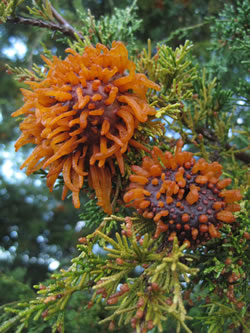Juniper-Apple Rust - Gymnosporangium juniperi-virginianae
- Aubrey
- Apr 19, 2021
- 2 min read
Updated: Sep 5, 2023
Good afternoon team. This week's mushroom is Gymnosporangium juniperi-virginianae, commonly known as Juniper-Apple Rust. This is a plant pathogen that requires both eastern red cedar (Juniperus virginiana) and apple (malus) - of which we have several of the latter and a handful of the former in the park - to complete its life cycle. The specimen pictured was found on a cedar directly above the oak bridge boat landing and Eric said he found the fungus on a cedar by the boathouse as well, both on 4/13/2021.
G. juniperi-virginianae is found commonly across eastern North America. It manifests itself in two different ways depending on which host plant it is on. It will appear as a gelatinous glob (seen in the attached pictures) on Eastern Red Cedar after one of the first warm rains of the spring. Eventually galls (plant tumors/abnormal growths) form on the branches. In their second year - or around twenty months after the initial infection - the galls then produce "spore horns" (fourth attached picture) that release spores which are then wind-blown to apple trees in the vicinity. The spores infect the apple trees as they are about to flower (or in the early flowering stage) and enter the tree through buds, young leaves, and branches. Small yellow lesions develop on the leaves after a few weeks and begin to ooze. Insects eat this ooze and carry fungal spores to other leaves of the tree where more fungal lesions form. In the summer, small tube-like structures develop on the underside of the lesions and release spores that are carried back to Eastern Red Cedars, thus repeating the cycle.
The fungus has been known to hinder fruit production and possibly compromise the structural integrity of the Eastern Red Cedars, but it doesn't seem to be a death sentence for either of the hosts. Apple orchards will cut down cedars within a couple miles of their orchards to prevent the fungus from infecting their trees. There are related fungal pathogens that use junipers and quince or hawthorns as their hosts as well. It has also been noted that the fungus doesn't manifest itself in the same way on some cultivars of Eastern Red Cedar and since the two in the ramble are from nurseries it will be interesting to see if we ever see spore horns form.
Nonetheless, I had no idea how interesting this fungus was when I stumbled upon these unassuming gelatinous globs in the rain. We're finally starting to see mushrooms pop out of the soil here in the park. Exciting times, keep your eyes peeled and send in any pictures of mushrooms you find.
Have a beautiful week,
Aubrey
References:
The fourth picture is from David D. Taylor and taken from the US Forest Service website.








